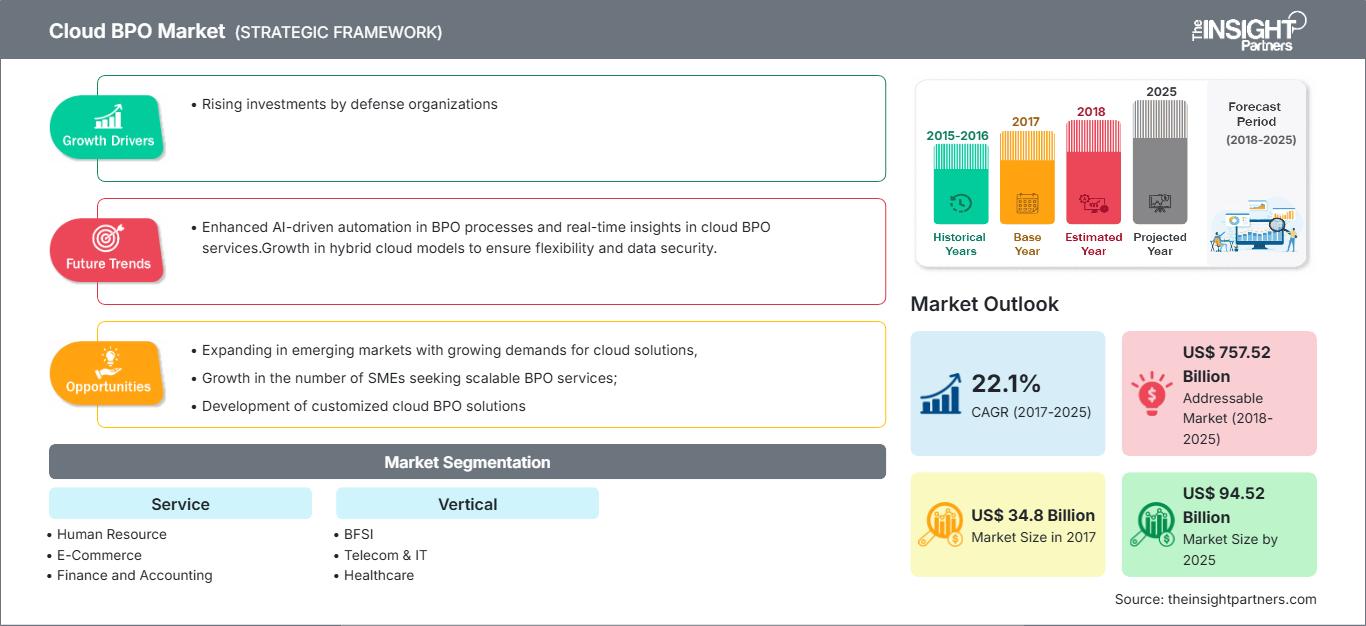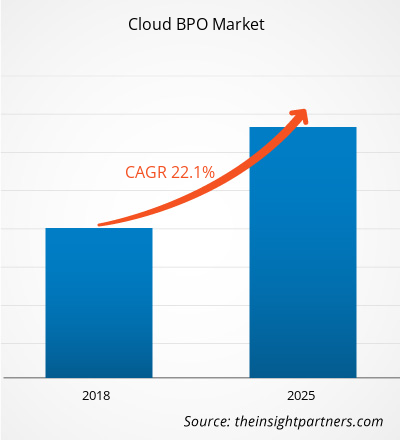Der Markt für Cloud-BPO wurde im Jahr 2025 auf rund 81,36 Milliarden US-Dollar geschätzt. Prognosen zufolge wird er bis 2034 auf rund 211,52 Milliarden US-Dollar anwachsen, was einer durchschnittlichen jährlichen Wachstumsrate (CAGR) von 11,2 % im Zeitraum 2026–2034 entspricht.
Marktanalyse für Cloud-BPO
Die Prognose für den Cloud-BPO-Markt deutet auf ein starkes Wachstum hin, bedingt durch die weitverbreitete Nutzung von Cloud Computing im Bereich Business Process Outsourcing (BPO), die Senkung der Betriebskosten und die verbesserte Agilität sowie die Fähigkeit cloudbasierter Modelle, umfangreiche und datenintensive Workflows zu bewältigen. Cloud-BPO ermöglicht es Outsourcing-Anbietern, die Kosten für die IT-Infrastruktur zu senken, die Datenverarbeitungszeit zu verkürzen und mit flexiblen Cloud-Ressourcen auf die sich wandelnden Kundenanforderungen einzugehen.
Marktübersicht Cloud BPO
Cloud-basiertes Business Process Outsourcing (Cloud-BPO) bezeichnet die Auslagerung von Geschäftsprozessdienstleistungen (wie Personalwesen, E-Commerce, Finanz- und Rechnungswesen, Kundenservice, Vertrieb und Marketing sowie weitere Supportprozesse) über cloudbasierte Infrastrukturen und Plattformen anstelle traditioneller On-Premise- oder Legacy-Outsourcing-Modelle. Zu den Vorteilen zählen Skalierbarkeit, Kosteneffizienz, geringerer Infrastrukturaufwand und schnellere Abwicklung datenintensiver Prozesse.
Da Unternehmen zunehmend Geschäftsfunktionen in die Cloud verlagern und an externe Cloud-BPO-Anbieter auslagern, wird Cloud-BPO zu einem Schlüsselfaktor für die digitale Transformation, die operative Agilität und globale Betriebsmodelle.
Passen Sie diesen Bericht Ihren Anforderungen an.
Sie erhalten eine kostenlose Anpassung aller Berichte – einschließlich Teilen dieses Berichts, Länderanalysen und Excel-Datenpaketen – sowie attraktive Angebote und Rabatte für Start-ups und Universitäten.
Cloud-BPO-Markt: Strategische Einblicke

-
Ermitteln Sie die wichtigsten Markttrends dieses Berichts.Diese KOSTENLOSE Probe beinhaltet eine Datenanalyse, die von Markttrends bis hin zu Schätzungen und Prognosen reicht.
Markttreiber und Chancen im Bereich Cloud BPO
Markttreiber:
- Steigende Nachfrage nach Kosteneinsparungen und Agilität bei Outsourcing-Dienstleistungen: Der Kostenvorteil von Cloud-BPO-Dienstleistungen (geringere Infrastrukturinvestitionen, höhere Skalierbarkeit) beeinflusst die Entscheidung zum Wechsel von traditionellen BPO-Modellen erheblich.
- Zunehmende Verbreitung von Cloud Computing in allen Branchen: Da Cloud Computing immer mehr zum Standard wird, nutzen BPO-Anbieter die Cloud, um datenintensive Prozesse zu bewältigen und schnellere Bearbeitungszeiten anzubieten.
- Bedarf an flexiblen, skalierbaren Outsourcing-Modellen: Unternehmen suchen Outsourcing-Partner, die ihre Kapazitäten dynamisch anpassen, Lastspitzen bewältigen und neue Services schnell integrieren können; Cloud-basiertes BPO erfüllt diese Anforderungen.
Marktchancen:
- Expansion in Schwellenländer mit Outsourcing-Wachstum: Regionen wie Asien-Pazifik, Lateinamerika, der Nahe Osten und Afrika bieten Wachstumspotenzial für Cloud-BPO-Dienstleistungen, da Unternehmen in diesen Regionen Cloud-Lösungen einsetzen und nicht zum Kerngeschäft gehörende Funktionen auslagern.
- Integration fortschrittlicher Technologien (KI, Analytik) in Cloud-BPO-Angebote: Cloud-BPO-Anbieter können sich differenzieren, indem sie Analytik, Automatisierung und KI in ihre Dienstleistungen einbetten und so die Prozesseffizienz, Genauigkeit und Wertschöpfung verbessern.
- Branchenspezifische Cloud-BPO-Lösungen: Das Angebot maßgeschneiderter Cloud-BPO-Dienstleistungen für spezifische Branchen (z. B. Banken, Finanzdienstleistungen und Versicherungen, Telekommunikation/IT, Gesundheitswesen) bietet die Möglichkeit, auf spezielle Bedürfnisse und Compliance-Anforderungen einzugehen.
Marktbericht Cloud BPO: Segmentierungsanalyse
Nach Service:
- Personalwesen
- E-Commerce
- Finanzwesen & Rechnungswesen
- Kundenservice
- Vertrieb & Marketing
Vertikal:
- BFSI
- Telekommunikation & IT
- Gesundheitspflege
- Automobil
- Herstellung
- Speisen und Getränke
- Strom und Energie
- Unterhaltungselektronik
Nach Geographie:
- Nordamerika
- Europa
- Asien-Pazifik
- Naher Osten und Afrika
- Süd- und Mittelamerika
Regionale Einblicke in den Cloud-BPO-Markt
Die regionalen Trends und Einflussfaktoren auf den Cloud-BPO-Markt im gesamten Prognosezeitraum wurden von den Analysten von The Insight Partners ausführlich erläutert. Dieser Abschnitt behandelt außerdem die Marktsegmente und die geografische Verteilung des Cloud-BPO-Marktes in Nordamerika, Europa, Asien-Pazifik, dem Nahen Osten und Afrika sowie Süd- und Mittelamerika.
Berichtsumfang zum Cloud-BPO-Markt
| Berichtattribute | Details |
|---|---|
| Marktgröße im Jahr 2025 | 81,36 Milliarden US-Dollar |
| Marktgröße bis 2034 | 211,52 Milliarden US-Dollar |
| Globale durchschnittliche jährliche Wachstumsrate (2026 - 2034) | 11,2 % |
| Historische Daten | 2021-2024 |
| Prognosezeitraum | 2026–2034 |
| Abgedeckte Segmente |
Durch den Service
|
| Abgedeckte Regionen und Länder |
Nordamerika
|
| Marktführer und wichtige Unternehmensprofile |
|
Marktdichte im Cloud-BPO-Bereich: Auswirkungen auf die Geschäftsdynamik verstehen
Der Markt für Cloud-BPO wächst rasant, angetrieben durch die steigende Nachfrage der Endnutzer. Gründe hierfür sind unter anderem sich wandelnde Verbraucherpräferenzen, technologische Fortschritte und ein wachsendes Bewusstsein für die Vorteile des Produkts. Mit steigender Nachfrage erweitern Unternehmen ihr Angebot, entwickeln innovative Lösungen, um den Kundenbedürfnissen gerecht zu werden, und nutzen neue Trends, was das Marktwachstum zusätzlich beflügelt.

- Verschaffen Sie sich einen Überblick über die wichtigsten Akteure im Cloud-BPO-Markt.
Marktanteilsanalyse für Cloud BPO nach Regionen
Nordamerika
- Marktanteil: Hält aufgrund einer ausgereiften Outsourcing-Branche und der frühen Einführung von Cloud-Lösungen einen bedeutenden Anteil.
- Wichtigste Einflussfaktoren: Große Anzahl an Outsourcing-Verträgen, hohe Akzeptanz von Cloud-Infrastruktur, Nachfrage nach kosteneffizienten BPO-Dienstleistungen.
- Trends: Verlagerung hin zu Cloud-nativen BPO-Modellen, Nutzung von Automatisierung und Analytik in BPO-Dienstleistungen.
Europa
- Marktanteil: Bedeutender Marktanteil aufgrund einer starken Outsourcing-Tradition und regulatorischer Bestrebungen hin zu digitalen Outsourcing-Modellen.
- Wichtigste Treiber: Nachfrage nach Cloud-basierten Outsourcing-Dienstleistungen, die den Datenschutzbestimmungen (z. B. DSGVO) entsprechen, Bedarf an länderübergreifenden Outsourcing-Modellen.
- Trends: Wachstum von Nearshore-Cloud-BPO-Modellen, zunehmende Nutzung von Cloud-BPO durch mittelständische Unternehmen.
Asien-Pazifik
- Marktanteil: Am schnellsten wachsende Region aufgrund expandierender Outsourcing-Märkte (Indien, Philippinen), zunehmender Cloud-Nutzung und Kostenvorteilen.
- Wichtigste Einflussfaktoren: Große Anzahl von BPO-Dienstleistern, die auf Cloud-Modelle umsteigen, wachsende Nachfrage nach Outsourcing-Dienstleistungen für Unternehmen und staatliche Initiativen zur Unterstützung der Cloud-Infrastruktur.
- Trends: Zunehmende Verbreitung von Cloud-BPO bei KMU, Wachstum mehrsprachiger und standortübergreifender Cloud-BPO-Zentren.
Süd- und Mittelamerika
- Marktanteil: Aufstrebende Region für die Einführung von Cloud-BPO.
- Wichtigste Einflussfaktoren: Nachfrage nach kosteneffizienten Outsourcing-Lösungen, Wachstum privater Kliniken und Fachzentren (im Bereich Healthcare BPO) sowie öffentlich-private Partnerschaften im Outsourcing-Bereich.
- Trends: Aufstieg von Cloud-BPO-Zentren in Lateinamerika, die mehrsprachige Dienstleistungen für Nordamerika und Europa anbieten; Wachstum im Bereich Cloud-basiertes Kundenservice-Outsourcing.
Naher Osten und Afrika
- Marktanteil: Entwicklungsmarkt mit starkem Wachstumspotenzial für Cloud-BPO-Implementierungen.
- Wichtigste Treiber: Nationale E-Governance-Strategien, expandierende Outsourcing-Branche, Infrastrukturausbau in Cloud- und Rechenzentren.
- Trends: Die Nutzung von Cloud-BPO für Backoffice-Dienstleistungen im Regierungs- und öffentlichen Sektor nimmt zu, ebenso die Nachfrage nach integriertem Outsourcing mit Cloud- und Analysefunktionen.
Marktdichte im Cloud-BPO-Bereich: Auswirkungen auf die Geschäftsdynamik verstehen
Der Markt für Cloud-BPO ist aufgrund der Präsenz großer globaler Outsourcing-Anbieter und Cloud-Service-Integratoren neben regionalen und spezialisierten Anbietern hart umkämpft. Dieses Umfeld zwingt die Anbieter dazu, sich durch folgende Maßnahmen zu differenzieren:
- Nahtlose Integration der Cloud-Infrastruktur mit BPO-Dienstleistungsmodellen
- Skalierbare, kosteneffiziente Cloud-BPO-Angebote, die sowohl auf Großunternehmen als auch auf mittelständische Kunden zugeschnitten sind.
- Einsatz von Automatisierung, Analytik und KI zur Verbesserung der Prozesseffizienz, Genauigkeit und Mehrwertdienste
- Interoperabilität mit Unternehmenssystemen, Einhaltung der Datensicherheitsstandards und die Fähigkeit, Outsourcing-Aktivitäten in mehreren Regionen abzudecken
Zu den wichtigsten Unternehmen, die auf dem Cloud-BPO-Markt tätig sind, gehören:
- Firstsource Solutions Ltd.
- WNS (Holdings) Ltd.
- Infosys Ltd.
- HCL Technologies Ltd.
- Genpact Ltd.
- Capgemini SE
- Atos SE
- Tata Consultancy Services Ltd.
- Accenture PLC
- IBM Corporation
Weitere im Rahmen der Studie analysierte Unternehmen:
- HP Inc. / Hewlett Packard Enterprise
- EXL Service Holdings, Inc.
- CGI Inc.
- Sutherland Global Services, Inc.
- Tech Mahindra Limited
- Concentrix Corporation
- Teleperformance SE
- Wipro Limited
- Cognizant Technology Solutions Corporation
- Fujitsu Ltd.
Neuigkeiten und aktuelle Entwicklungen
- Die hohe Akzeptanz von Cloud-Computing in verschiedenen Regionen bietet Anbietern von Cloud-BPO-Dienstleistungen erhebliche Möglichkeiten, ihren Marktanteil zu erhöhen.
- Bedenken hinsichtlich der Datensicherheit (Datenlecks, Malware-Einschleusung, Ransomware, Denial-of-Service-Angriffe) bleiben eine zentrale Herausforderung bei der Expansion von Cloud-BPO.
Berichtsumfang und Ergebnisse
Der Bericht „Cloud BPO-Markt – Größe und Prognose (2021–2034)“ bietet eine detaillierte Analyse, die Folgendes umfasst:
- Marktgröße und Prognose für den Cloud-BPO-Markt auf globaler, regionaler und Länderebene für alle wichtigen Marktsegmente, die im Rahmen des Berichts abgedeckt werden
- Trends im Cloud-BPO-Markt sowie Marktdynamiken wie Treiber, Hemmnisse und wichtige Chancen
- Detaillierte PEST- und SWOT-Analyse
- Die Analyse des Cloud-BPO-Marktes umfasst wichtige Markttrends, globale und regionale Rahmenbedingungen, Hauptakteure, regulatorische Bestimmungen und aktuelle Marktentwicklungen.
- Branchenlandschaft und Wettbewerbsanalyse mit Fokus auf Marktkonzentration, Heatmap-Analyse, führende Akteure und aktuelle Entwicklungen im Cloud-BPO-Markt
- Detaillierte Unternehmensprofile
- Historische Analyse (2 Jahre), Basisjahr, Prognose (7 Jahre) mit CAGR
- PEST- und SWOT-Analyse
- Marktgröße Wert/Volumen – Global, Regional, Land
- Branchen- und Wettbewerbslandschaft
- Excel-Datensatz
Aktuelle Berichte
Erfahrungsberichte
Grund zum Kauf
- Fundierte Entscheidungsfindung
- Marktdynamik verstehen
- Wettbewerbsanalyse
- Kundeneinblicke
- Marktprognosen
- Risikominimierung
- Strategische Planung
- Investitionsbegründung
- Identifizierung neuer Märkte
- Verbesserung von Marketingstrategien
- Steigerung der Betriebseffizienz
- Anpassung an regulatorische Trends






















 Kostenlose Probe anfordern für - Cloud-BPO-Markt
Kostenlose Probe anfordern für - Cloud-BPO-Markt